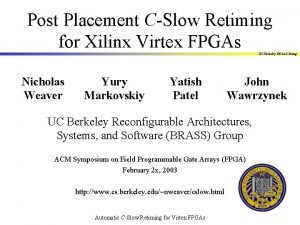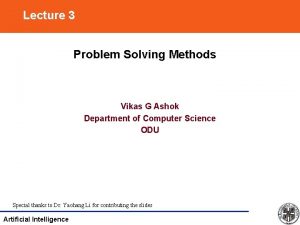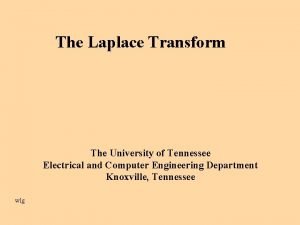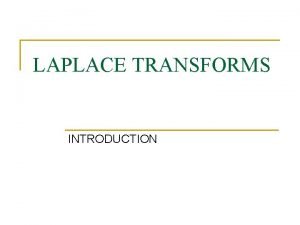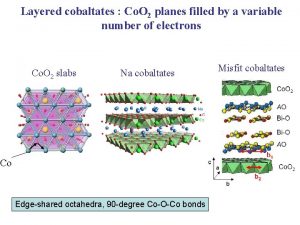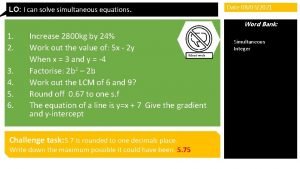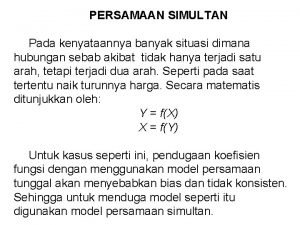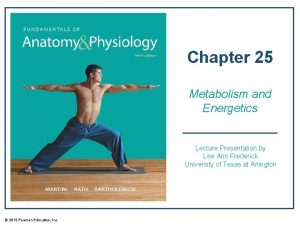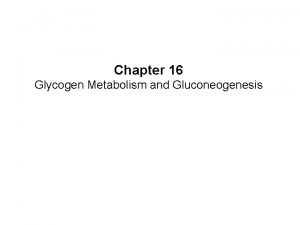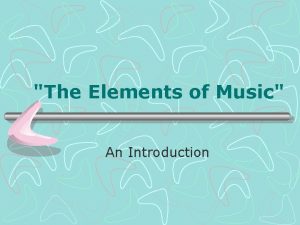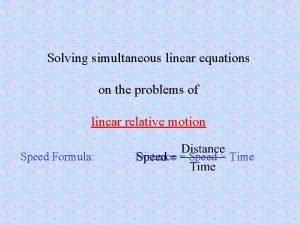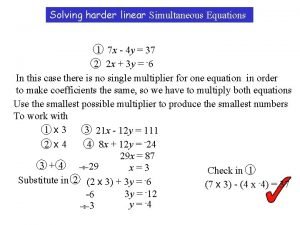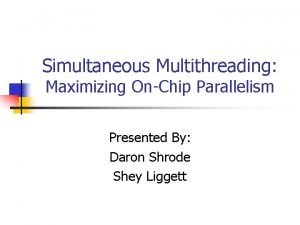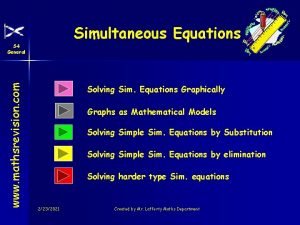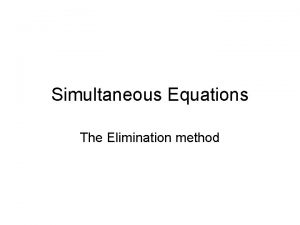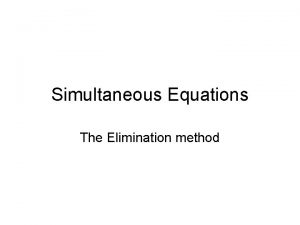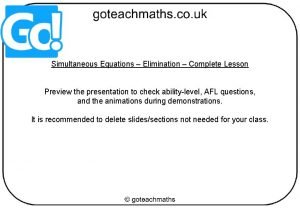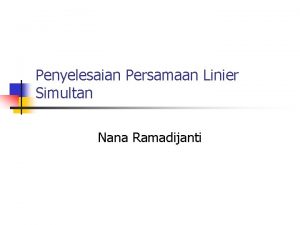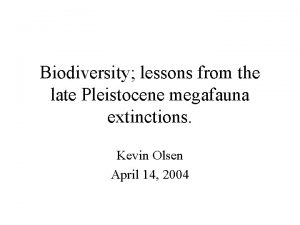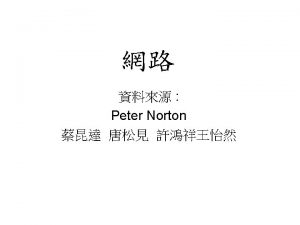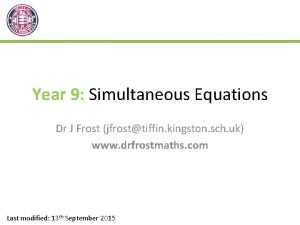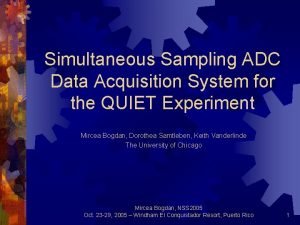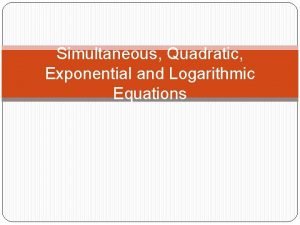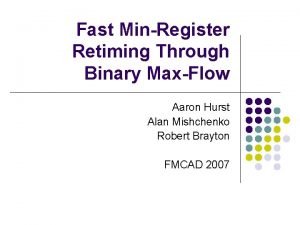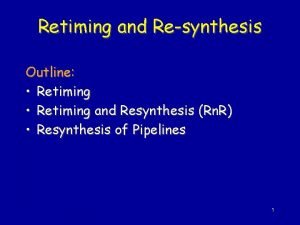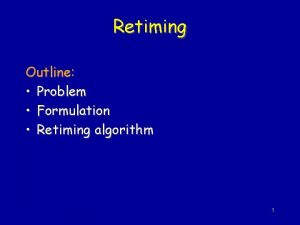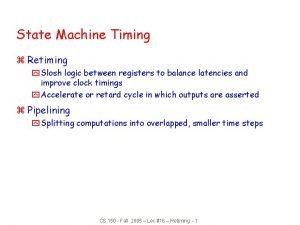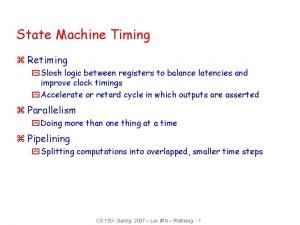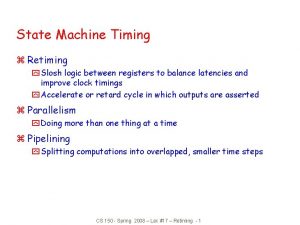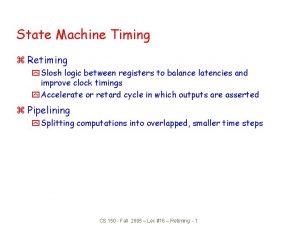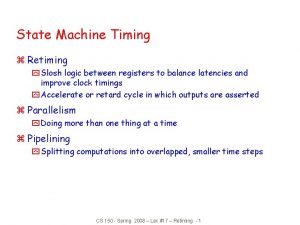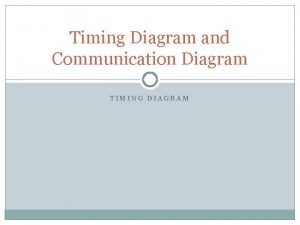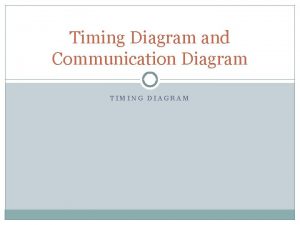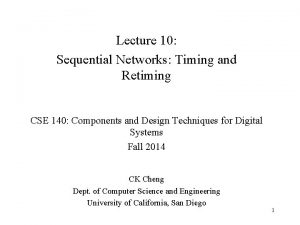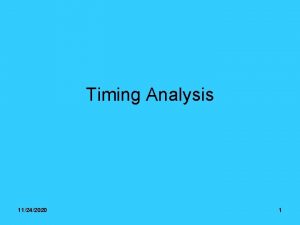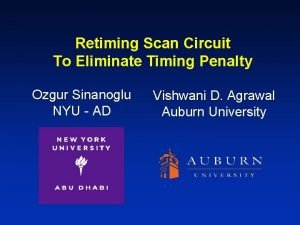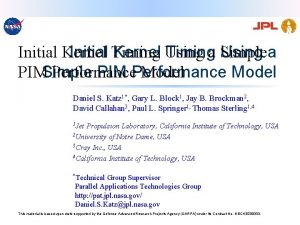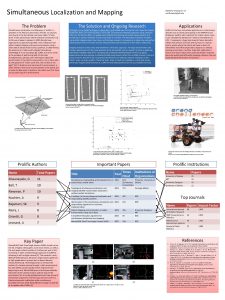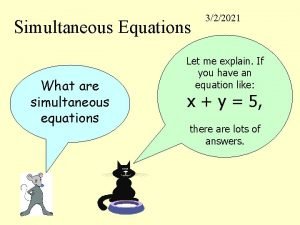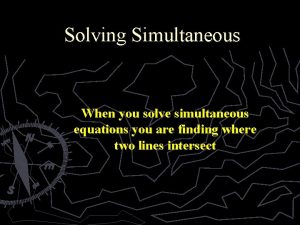MinRegister Retiming Under Simultaneous Timing and Initial State















![Asymptotic Analysis l Single iteration runtime limited by maximum flow solver [Goldberg 95] l Asymptotic Analysis l Single iteration runtime limited by maximum flow solver [Goldberg 95] l](https://slidetodoc.com/presentation_image_h2/d6fa92e96e1d0c6cbe3df90989df1504/image-16.jpg)























- Slides: 39

Min-Register Retiming Under Simultaneous Timing and Initial State Constraints Aaron Hurst Dec. 2007

Introduction l Retiming is the structural relocation of registers such that output functionality is preserved l Transformation with many means and many ends l l l Minimizing worst-case delay Minimizing number of registers Either of the above under constraints Optimally or heuristically Other… ? In an industrial setting? l 1. 2. Diminishing returns in combinational optimization Coming of age of sequential equivalence checking

Motivation Register minimization is uniquely valuable l l Area and power reduction l Clock network: dynamic power, design effort Testability: scan chain depth Verification: state representation l l Must satisfy several constraints l l Timing, initializability, congestion, electrical. . . Constrained minimum-register retiming is hard l l Current solutions not scalable

Outline Core problem 1. l unconstrained register minimization 2. Constraints: Timing 3. Constraints: Initializability 4. Other constraints

Flow-Based Register Minimization A New Approach to Unconstrained Register Minimization

Background l Register minimization an “original” problem in retiming r(v): retiming lag wi(u, v): initial reg count l An instance of minimum-cost network flow [Goldberg 97] But we can do better. . .

Orientation l Consider one combinational frame of the circuit l A single directed acyclic graph of combinational logic l l Nodes: Edges: Inputs: Outputs: logic gates pair-wise net connections register outputs, primary inputs registers inputs, primary outputs primary inputs register outputs

Cuts in a Frame l Consider circuit w/o primary IOs and their transitive fan-in/out l l Retiming = a complete cut of the DAG Number of registers = l Problem consists of finding minimum cut

Max-Flow Formulation l Min-cut/Max-flow Duality l l l Edges in graph are assigned a capacity Min-cut width = Max-flow through graph Min-cut derived from residual flow l Partition graph into {S, R} by source reachability l l l sink S = augmenting path from source s R = augmenting path from source s Min-cut is not unique l Selects one with min movement of registers source

Constraint Type #1 l What are the effect of unconstrained edges? v u l Never saturated; always present in residual graph l l Destination node v always reachable from source u Minimum cut will never lie between u and v A useful tool for constraining solution. .

A Necessary Modification l l Min-cut guarantees every path will be cut at least once Retiming requires that every path is cut exactly once R R 2’ R 1 R 2 R 3’ R 3 S l Observation: a path must cross cut from R → S l Solution: Use unconstrained flow to prevent reverse edges

Fanout Sharing l l Nets were decomposed into flow arcs False model of register count l l l 1 11 Reality: one register per net / hyper-edge “Fanout sharing” 1 1 Introduce a structure to simulate fanout-sharing 1 1 1 1

Single Iteration l 1. 2. What is the final flow graph? Reverse Edges Fanout-sharing 1 1 1 l Unitary Flow Simplification l l Binary marking scheme Flow computed on original netlist 1 1 1 1

Multiple Frames l Globally minimum solution requires moving registers beyond one frame l l Corresponding min-cut may stretch across multiple combinational frames Solution: Repeat over single frame l Terminate when no further change l Then, consider backward direction l Final result is provably optimal unrolled circuit

Overall Algorithm Start Forward retiming Backward retiming Block Fan-out Cone of PIs Block Fan-in Cone of POs Compute Max-Flow y Implement Min-Cut n Improv. ? y Implement Min-Cut Improv. ? n l Forward retiming is preferred due to initial state computation Done
![Asymptotic Analysis l Single iteration runtime limited by maximum flow solver Goldberg 95 l Asymptotic Analysis l Single iteration runtime limited by maximum flow solver [Goldberg 95] l](https://slidetodoc.com/presentation_image_h2/d6fa92e96e1d0c6cbe3df90989df1504/image-16.jpg)
Asymptotic Analysis l Single iteration runtime limited by maximum flow solver [Goldberg 95] l Or, using unitary flow simplification… l Total number of iterations is bounded by |R|

Experimental Results l Applied to {ISCAS, ITC, Open. Cores, Altera} benchmarks. . . Register Savings per Iteration l The number of iterations is quite small l Register count is monotonically decreasing l l Runtime can be bounded Runtime is 5 x faster than minimum-cost formulation l <0. 01 s for 70% of benchmarks

Summary Key points: 1. Optimal 2. Minimum register movement 3. Fast. . . both absolutely and relatively 4. Scalable: early termination with improvement

Timing Constraints

Background l Timing constraints make problem much harder D(u, v): path delay W(u, v): path reg count l Complexity: pair-wise path delay constraints l Enumeration alone is O(n 3) l Simplification: prune unnecessary constraints l Minaret: use skew-equivalence to find ASAP and ALAP register positions [Sapatnekar 99]

Conservative Constraints l Consider retiming a register l Two timing constraints made potentially critical in each direction max minarrival l If other end of timing constraints is fixed. . . l l max minarrival Bound on absolute positions of register All such constraints can be computed with two-pass STA l Linear time

Exact Constraints l Fixing other end of timing path is conservative l l May also move in the same direction, relaxing constraint If other end of timing constraints is not fixed. . . l Conditional constraints “Can retime R 2 past v 2 only if R 1 is retimed past v 1” R 1 v 1 R 2 v 2 unit delay max delay 3 l Computed from edge of bounded transitive fan-in/out cone - delay - register count

Constraint Implementation l Conservative Constraints: l l Indicate nodes to be removed from problem Exact Constraints: l Implemented as unconstrained edges v 1 l v 2 Cut can only move beyond v 2 if it moves beyond v 1

Refinement l All timing constraints met by initial circuit l l l Guarantees flow from source to sink remains finite Iteratively tighten conservative constraints into exact ones Simplification: Only constraints limiting area improvement Ccons = all Cexact = minexact+cons compute cut with Ccons compute cut w/o Ccons y convert ccons between two cuts into cexact Conservative Constraint any? n

Building Intuition 4 5 6 unit delay max delay 3 4 No Constraint Conservative Constraint Exact Constraint l minexact+cons Constraints impose relations across multiple clock cycles

Building Intuition unit delay max delay 2 No Constraint Conservative Constraint Exact Constraint l minexact+cons Cycles in constraints lock retiming moves to be ‘in-step’

Experimental Results Max path delay initial period, min path delay ≥ 0 l l Average number of exact constraints = 1. 1% of design size

Summary Key points: 1. Inherits benefits of flow-based retiming 1. 2. 3. Optimal Fast Monotonic improvement 2. Problem reduced using both timing and area criticality 3. Advanced timing model and constraints 4. Scalable: intermediate solutions are timing-feasible

Initializability Constraints

Problem l Retimed circuit must preserve initialization behavior l Accomplished by: 1. 2. Additional combinational logic Identifying an equivalent initial state forward retiming: simulation 0 ? backward retiming: l SAT Backward retiming jeopardizes initializability 0

Background l How to transform an uninitializable circuit into an initializable one? l ‘Prayer’ minimizing register movement maximizes initializability [Pan 99] l ‘Slash and Burn’ incrementally tighten bound on negative retiming lag [Stok 95] l ‘Brute Force’ mixed-integer linear program [Sapatnekar 97]

Feasibility Constraints SAT problem with variables Feasibility Constraint : l Parital cut of unrolled circuit Sufficient to imply infeasibility l ? l At least one element must be removed UNSAT with only variables in TFO( ) l ? l 0 Built incrementally as retiming progresses 0 l Variables switched off in SAT with additional per-clause variables z

Feasibility Constraints l Topologically order circuit y l l Fast: Faster: 0 y v ? SAT ? n n ? binary search on v 0 0 = Incremental SAT UNSAT core can be used to localize conflict

Constraint Type #2 Penalty Structure 0 l source Adds exactly one unit flow path Delayed insertion until comes into frame l 0 l Biases against cuts below feasibility constraint l l Closest cut of width +1 returned Cut is squeezed forward l New cut of width +1 is closest and therefore most initializable l If it isn’t. . . additional penalty needed sink

Algorithm Cfeas = compute min-cut constrained by Cfeas initializable? n Cfeas = y binary search on v n l SAT y n SAT y v Complexity: already NP-complete from test for initializability

Experimental Results l Equivalent init. state after min-reg retiming for most designs Only one design was not initializable: s 400 Can be easily lost if backward retiming invoked multiple times l l l A harder problem: randomized initial states Original Name Gates Regs Infeasible Feasible Min-Register Regs Avg. | | Runtime s 400 0. 3 k 21 18 +1 8. 0 0. 08 s oc_aes_core 16. 6 k 402 395 +3 2. 0 2. 55 s oc_vga_lcd 17. 1 k 1108 1087 +1 1. 09 s nut_003 6. 6 k 484 450 +3 1. 0 1. 41 s radar 12 71. 1 k 3875 3771 +27 2. 3 108. 3 s oc_wb_dma 29. 2 k 1775 1757 +2 3. 5 5. 70 s oc_minirisc 3. 9 k 289 271 +2 1. 0 0. 49 s

Summary Key points: 1. Optimal 2. Compatible with timing constraints 3. Worst-case bound non-polynomial, but fast in practice

Additional Applications l Physical constraints l l Electrical constraints l l Placement congestion: penalty structures Capacitive load on clock network drivers: penalty structures Others?

Contribution l New formulation of register minimization problem l Constraints of different forms can be added to problem 1. 2. 3. Timing Initializability Other l Improves upon best practices within each sub-problem Unified solution to synthesis-ready retiming l Scalable l
 Vivado retiming
Vivado retiming Retiming example
Retiming example Retiming example
Retiming example What is initial state + goal state in search terminology?
What is initial state + goal state in search terminology? Initial and final value theorem
Initial and final value theorem Final value theorem
Final value theorem Niproxim
Niproxim How to solve simultaneous equations
How to solve simultaneous equations Simultaneous grinding and spray drying
Simultaneous grinding and spray drying Simultaneous heat and mass transfer
Simultaneous heat and mass transfer Simultaneous integration and sequential integration
Simultaneous integration and sequential integration Contoh simultan
Contoh simultan Contoh kasus model persamaan simultan dan penyelesaiannya
Contoh kasus model persamaan simultan dan penyelesaiannya Persamaan linier 1 variabel
Persamaan linier 1 variabel Good state graphs and bad state graphs in software testing
Good state graphs and bad state graphs in software testing Absorptive state vs postabsorptive state
Absorptive state vs postabsorptive state Glycogen breakdown
Glycogen breakdown State state graphs and transition testing
State state graphs and transition testing Elemts of music
Elemts of music Worksheet on simultaneous linear equations
Worksheet on simultaneous linear equations Linear equation solver with steps
Linear equation solver with steps What is simultaneous multithreading
What is simultaneous multithreading Simultaneous equations step by step
Simultaneous equations step by step If the signs are the same in simultaneous equations
If the signs are the same in simultaneous equations Elimination method simultaneous equations
Elimination method simultaneous equations Simultaneous equations
Simultaneous equations Elimination method example
Elimination method example Persamaan linier simultan
Persamaan linier simultan Emergency evacuation training
Emergency evacuation training Simultaneous extinction
Simultaneous extinction Simultaneous extinction
Simultaneous extinction Simultaneous access
Simultaneous access Simultaneous equations dr frost
Simultaneous equations dr frost Simultaneous interpreting definition
Simultaneous interpreting definition Quadratic simultaneous equation
Quadratic simultaneous equation Simultaneous interpretation in turkey
Simultaneous interpretation in turkey Force summation biomechanics
Force summation biomechanics Kagan strategies for math
Kagan strategies for math Simultaneous sampling daq
Simultaneous sampling daq Quadratic logarithmic equations
Quadratic logarithmic equations
